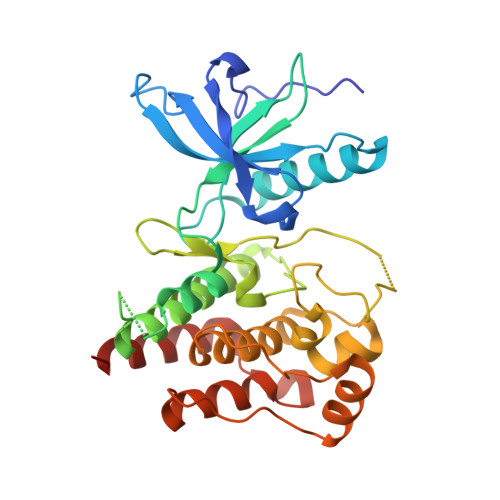Lenvatinib inhibits angiogenesis and tumor fibroblast growth factor signaling pathways in human hepatocellular carcinoma models.
Matsuki, M., Hoshi, T., Yamamoto, Y., Ikemori-Kawada, M., Minoshima, Y., Funahashi, Y., Matsui, J.(2018) Cancer Med 7: 2641-2653
- PubMed: 29733511
- DOI: https://doi.org/10.1002/cam4.1517
- Primary Citation of Related Structures:
5ZV2 - PubMed Abstract:
Unresectable hepatocellular carcinoma (uHCC) is one of the most lethal and prevalent cancers worldwide, and current systemic therapeutic options for uHCC are limited. Lenvatinib, a multiple receptor tyrosine kinase inhibitor targeting vascular endothelial growth factor receptors (VEGFRs) and fibroblast growth factor receptors (FGFRs), recently demonstrated a treatment effect on overall survival by statistical confirmation of noninferiority to sorafenib in a phase 3 study of uHCC. Here, we investigated mechanisms underlying the antitumor activity of lenvatinib in preclinical HCC models. In vitro proliferation assay of nine human HCC cell lines showed that lenvatinib selectively inhibited proliferation of FGF signal-activated HCC cells including FGF19-expressing Hep3B2.1-7. Lenvatinib suppressed phosphorylation of FRS2, a substrate of FGFR1-4, in these cells in a concentration-dependent manner. Lenvatinib inhibited in vivo tumor growth in Hep3B2.1-7 and SNU-398 xenografts and decreased phosphorylation of FRS2 and Erk1/2 within the tumor tissues. Lenvatinib also exerted antitumor activity and potently reduced tumor microvessel density in PLC/PRF/5 xenograft model and two HCC patient-derived xenograft models. These results suggest that lenvatinib has antitumor activity consistently across diverse HCC models, and that targeting of tumor FGF signaling pathways and anti-angiogenic activity underlies its antitumor activity against HCC tumors.
Organizational Affiliation:
Tsukuba Research Laboratories, Eisai Co., Ltd., Ibaraki, Japan.















